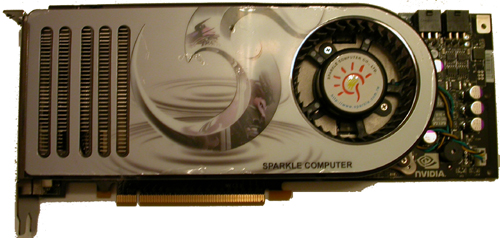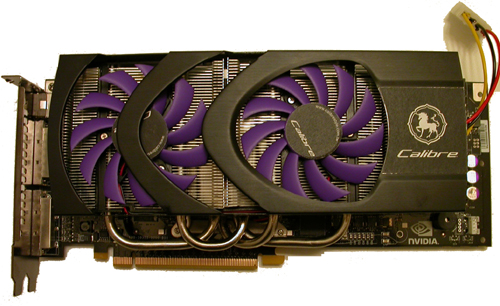GeForce 8800 Roundup: The Best of the Best
by Josh Venning on November 13, 2006 11:04 AM EST- Posted in
- GPUs
Sparkle GeForce 8800 GTX
Sparkle sent us two cards, one based on NVIDIA's reference design and the other with a more exotic cooling system in place.

First we have the reference 8800 GTX from Sparkle. The card looks no different from NVIDIA's reference 8800 GTX aside from a few Sparkle graphics on the heatsink. Keep in mind that even though many of the 8800 GTXs look nearly the same, each manufacturer puts their own modifications in the card's BIOS, which affect things like fan speeds and power consumption. These modifications will also affect how well each of these cards overclock, which we will look at in the next section.
Sparkle Calibre 8800 GTX
For those of you who don't want to be seen with a regular 8800 GTX, Sparkle has what you've been looking for. Sparkle has been getting attention lately with its new Calibre line of graphics cards, which make some pretty radical changes in card and HSF designs, and their Calibre 8800 GTX is no exception. The Sparkle Calibre 8800 GTX departs dramatically from the reference design through the use of two cooling fans and a peltier cooling element.

The two fans on the card are used to cool the thermo-electric element, which in turn cools the GPU. The card not only has the standard two PCIe power connectors, but it also has a 4-pin power connector just to power the peltier element. Because of this extra power requirement, we'll see higher power consumption from this card than the others, but as our tests will show, the peltier cooler makes the card run very cool during stressful operation.










34 Comments
View All Comments
JarredWalton - Monday, November 13, 2006 - link
Derek already addressed the major problem with measuring GPU power draw on its own. However, given similar performance we can say that the cards are the primary difference in the power testing, so you get GTX cards using 1-6w more power at idle, and the Calibre uses up to 15W more. At load, the power differences cover a 10W spread, with the Calibre using up to 24W more.If we were to compare idle power with IGP and an 8800 card, we could reasonably compare how much power the card requires at idle. However, doing so at full load is impossible without some customized hardware, and such a measurement isn't really all that meaningful anyway if the card is going to make the rest of the system draw more power anyway. To that end, we feel the system power draw numbers are about the most useful representation of power requirements. If all other components are kept constant on a testbed, the power differences we should should stay consistent as well. How much less power would an E6400 with one of these cards require? Probably somewhere in the range of 10-15W at most be likely.
IKeelU - Monday, November 13, 2006 - link
Nice roundup. One comment about the first page, last paragraph:"HDMI outputs are still not very common on PC graphics cards and thus HDCP is supported on each card."
Maybe I'm misinterpreting, but it sounds like you are saying that HDCP is present *instead* of HDMI. The two are independent of each other. HDMI is the electrical/physical interface, whereas HDCP is the type of DRM with which the information will be encrypted.
Josh Venning - Monday, November 13, 2006 - link
The sentence has been reworked. We meant to say HDCP is supported through DVI on each card. Thanks.TigerFlash - Monday, November 13, 2006 - link
Does anyone know if the Evga WITH ACS3 is what is on retail right now? Evga's website seems to be the only place that distinguishes the difference. Everyone else is just selling an "8800 GTX."Thanks.
Josh Venning - Monday, November 13, 2006 - link
The ACS3 version of the EVGA 8800 GTX we had for this review is apparently not available yet anywhere, and we couldn't find any info on their website about it. Right now we are only seeing the reference design 8800 GTX for sale from EVGA, but the ACS3 should be out soon. The price for this part may be a bit higher, but our sample has the same clock speeds as the reference part.SithSolo1 - Monday, November 13, 2006 - link
They have two different heat sinks so I assume one could tell by looking at the product picture. I know a lot of sites use the product picture from the manfacture's site but I think they would use the one of the ASC3 if that's the one they had. I also assume they would charge a little more for it.imaheadcase - Monday, November 13, 2006 - link
Would love to see how these cards performance in Vista, even RC2 would be great.I know the graphics drivers for nivdia are terrible, i mean terrible, in vista atm but when they at least get a final out for 8800 a RC2 or a Vista final roundup vs winxp SP@ would be great :D
DerekWilson - Monday, November 13, 2006 - link
Vista won't be that interesting until we see a DX10 driver from NVIDIA -- which we haven't yet and don't expect for a while. We'll certainly test it and see what happens though.imaheadcase - Monday, November 13, 2006 - link
Oh the current drivers for the 8800 beta do not support DX10? Is that the new detX drivers I read about Nvidia working on are for?peternelson - Saturday, November 25, 2006 - link
I'd be interested to know if the 8800 drivers even support SLI yet? The initial ones I heard of did not.